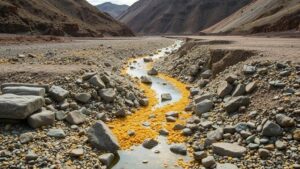Techniques for Identifying Gold in Subsurface Gravel Deposits
Techniques for Identifying Gold in Subsurface Gravel Deposits
The pursuit of gold has fascinated humanity for centuries, and modern methodologies for locating this precious metal have evolved significantly. One challenging environment where gold deposits can be found is in subsurface gravel deposits–areas that may conceal valuable resources beneath layers of sediment. This article explores practical techniques for identifying gold in these deposits, employing a blend of traditional methods and contemporary advancements.
Understanding Gold Formations
Before delving into identification techniques, it is essential to understand where and how gold occurs in gravel deposits. Gold typically becomes concentrated in certain areas due to natural processes such as erosion and sediment transport. Fluvial systems often serve as key locations for gold deposit formation, wherein rivers can wash gold particles downstream, leading to accumulation in gravel beds.
Geological Surveys and Mapping
One effective technique for identifying potential gold-rich areas is through geological surveys and mapping. The process involves analyzing geological maps that outline the types of bedrock and sedimentary deposits present in a given area. Key geological indicators include:
- Quartz Veins: Gold is often associated with quartz, and locating quartz veins can lead prospectors to potential gold deposits.
- Alluvial Deposits: Riverbeds and floodplains where sediments have accumulated can be prime areas for gold deposits.
- Fault Lines: Geological fault lines may indicate areas of mineralization where gold could be deposited.
By utilizing satellite imagery and Geographic Information Systems (GIS), geologists can accurately map these features and identify promising exploration sites.
Soil Sampling Techniques
Soil sampling is a reliable method to assess the presence of gold in subsurface deposits. This technique involves taking samples from various depths and locations to analyze for the presence of gold particles. The advantages of soil sampling include:
- Targeted Exploration: By analyzing specific depths, prospectors can focus on layers most likely to contain gold.
- Cost-Effectiveness: Soil sampling can be conducted with minimal equipment, making it accessible for small-scale prospectors.
For example, a case study in Californias Sierra Nevada range identified high concentrations of gold in soil samples taken at depths of 3 to 5 feet, leading to successful excavation projects.
Panning and Sluicing Techniques
Traditional methods such as panning and sluicing remain popular among hobbyists and professionals alike. e techniques involve processing gravel and sediment to separate gold from other materials. Key aspects of these techniques include:
- Panning: This method uses a shallow pan to wash sediment, allowing lighter materials to wash away while the heavier gold particles settle to the bottom.
- Sluicing: A sluice box is a more advanced tool that uses water flow to separate gold from larger gravel deposits, increasing efficiency.
The success of these methods depends significantly on the skill of the user and the characteristics of the sediment being processed. For example, the effectiveness of sluicing dramatically improves when applied to materials with a high percentage of gold content.
Modern Technology: Geophysical Methods
Advancements in technology have introduced geophysical methods for identifying gold deposits beneath surface layers. Techniques such as ground-penetrating radar (GPR) and electromagnetic surveys can reveal valuable information about subsurface structures. Benefits of these methods include:
- Non-invasive: These techniques allow for analysis without disturbing the sediment, preserving the environment.
- Detailed Mapping: Geophysical tools can offer a clearer picture of subsurface compositions, improving the precision of exploration efforts.
A recent study demonstrated the efficacy of GPR in locating buried gold deposits in Alaskas extensive gravel terraces, effectively guiding subsequent excavation activities.
Environmental Considerations
While exploring for gold, it is crucial to consider environmental implications. Mining and prospecting activities can disrupt local ecosystems. Sustainable practices, such as responsible waste disposal and rehabilitation of mined areas, are essential for minimizing environmental impact. The adoption of eco-friendly techniques not only preserves habitats but also enhances public perception of the mining industry.
Conclusion
Identifying gold in subsurface gravel deposits presents numerous challenges, yet a combination of traditional and modern techniques can yield successful results. From geological surveys and soil analysis to innovative geophysical methods, prospective gold seekers have a variety of tools at their disposal. Also, keeping environmental considerations in mind ensures that the quest for this precious metal is conducted responsibly. Ultimately, a thorough understanding of the techniques outlined in this article can enhance both novice and seasoned prospectors abilities to uncover gold-rich deposits.
Actionable Takeaway: For those interested in exploring subsurface gravel deposits, starting with geological mapping and simple panning techniques can provide valuable insights before investing in more advanced technologies.



